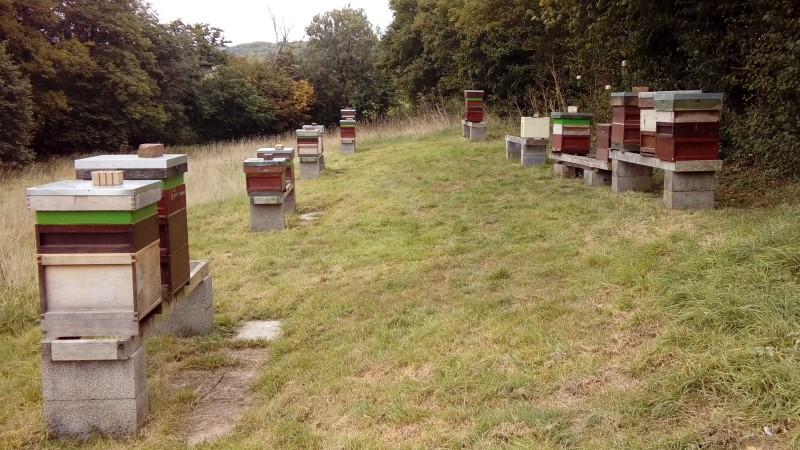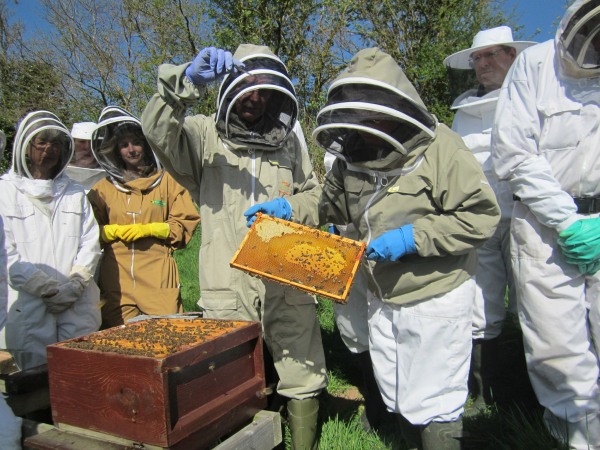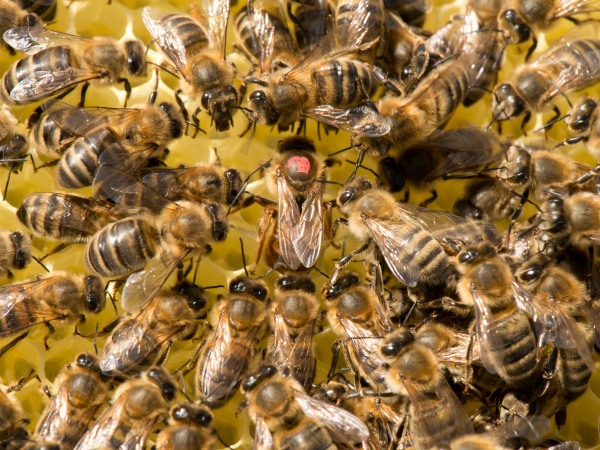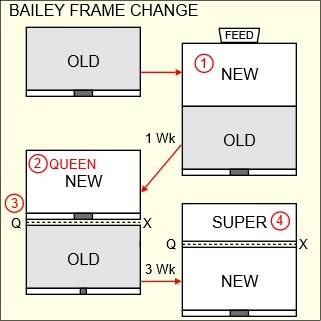Members – Branch Apiary
Sub-pages: │ Multi-queen Hives │ Bee Health │

We hold fortnightly meetings at the Branch Apiary during spring and summer, April to September inclusive, where members are given the opportunity for hands-on instruction and have the opportunity to exchange views with experienced beekeepers.
Non-members are welcome to come and see what we do, but this is limited to one meeting to conform to our insurance. If you wish to attend please contact a committee member. Non-members may also come to one winter meeting without joining to get a taste of what we do.

Hive Records
We encourage all beekeepers to keep some form of hive record sheet. The format of the sheet is very much a personal matter dependent on many factors. Download the Hive Record Sheet (PDF file) used at the Branch Apiary and use as your starting point.
You are legally obliged to keep records of any veterinary medicines used on your bees. Download a Veterinary Medicines Record Sheet (PDF file) which gives all the details.
Stings
When a bee stings it injects venom through a fine barbed point. This is usually torn out of the abdomen when the bee flies away and is left behind in the wound. The sac will continue to pump venom, so the quicker it is removed the better. This should be done by scraping the sting out of the wound with a blade, hive tool or fingernail without compressing it.

Sample of bees for Nosema analysis
30 bees must be examined in order to complete the diagnosis. Condition of the bees is also important. Freshly killed bees are best. Avoid using plastic containers as this leads to more rapid sample degradation. A standard sized matchbox is ideal.
To collect your sample, wait until the bees are flying then block the entrance with a piece of plastic foam. Hold a plastic bag open in front of the entrance so that the returning bees go inside the bag. When you judge there are 30+ bees inside the bag, close it and put it in a freezer or freezer compartment of a fridge.
Living with Varroa
BeeBase provides comprehensive documentation on Varroa management, with up-to-date details of the life cycle, spread and control of this pest in honey bee colonies. Click the link to view or download their PDF file Managing Varroa.
Comb Changing
Why change the comb?
- Reduces disease burden.
- Reduces build up of chemicals from varroa treatment etc.
- Repeated use of old comb reduces cell size > smaller bees.
- Building new comb is how wild bees control disease.
Requirements
- Bees need to be 2 weeks old to ensure wax glands are well developed. Wax glands of older bees atrophy.
- Clean boxes, floors, frames and foundation.
- Syrup or sugar solution (1kg sugar / 600ml water) in large bucket feeder.
- “Warmish” weather, March onwards.
- Strong colonies with lots of bees.
Bailey frame change
The gentle way to change all the old comb in the brood box. Does not affect the laying of brood, colony build up or honey yield.
- Place a clean box of foundation on top of the old brood box, feed with syrup and leave for a week.
- When at least one frame of new foundation has been drawn find the queen and place her in the new box.
- Put a queen excluder between the two brood boxes with a new entrance above the queen excluder. You may also wish to leave a small exit hole for drones in the original entrance.
- After 3 weeks all brood in the old box will have emerged. Remove the old box and frames and recycle.Supers can be placed above the new brood box (with queen excluder).

Keep it clean!
Simplifying the disinfecting process
Kirsty Stainton, a Bee Scientist, recently wrote an article for BBKA News outlining the methods that hobbyist beekeepers can use to simplify the disinfection of beekeeping equipment. The article can be found on the BBKA News website, www.bbkanews.com, August 2022, page 270. Note: you will need your BBKA membership number and your postcode to access the archive.
What are we up against?

Fungi
Nosema apis and Nosema ceranae (adult fungal diseases).
Chalkbrood, Ascosphaera apis, (fungal brood disease).

Viruses
CBPV, chronic bee paralysis virus (affecting adult bees).
DWV, deformed wing virus (affecting adults and brood).
Sacbrood, sacbrood virus (affecting larvae).

Bacteria
European foul brood, Melissococcus plutonius, and American foul brood, Paenibacillus larvae, both bacterial diseases affecting brood.
Scrape all surfaces
Before using any disinfectant, scrape and wire brush equipment to remove wax, propolis and organic residues, including dead bees.
Safety
These chemicals are dangerous so appropriate PPE should be used. Safety instructions are usually given on the label.
We will describe just two simple methods for decontaminating bee equipment.
Washing soda
Make a solution of washing soda crystals (sodium carbonate). Washing soda is readily available in hardware stores. Use 1kg crystals to 5 litres water and use at 80°C or above to disinfect equipment. It should be noted that it does not work on all viruses and will not be fully effective in hard water areas. That said, East Devon teaching apiary use this method to sterilise all used frames before reuse.
After sterilising, rinse well with cold water and allow to dry before storing equipment.
Bleach
This is one of the best, cheapest and most effective disinfectants for decontamination of equipment, especially after a disease outbreak. It is capable of killing bacteria and AFB spores (within 20 minutes) and will sterilise Nosema and viruses. In addition, equipment can be washed off easily leaving no harmful residues to damage your bees.
Preparation of bleach solution
As most household bleach is sold as a 5% sodium hypochlorite solution, this should be diluted 1 in 10 with cold water to make a 0.5% solution for decontaminating bee equipment. Make sure the added water is cold, as hot water inactivates bleach.
Use of 0.5% bleach solution
Nonporous surfaces will only take 10 minutes contact time, but porous surfaces like wood or polystyrene need a minimum of 30 minutes. Give it 1 hour to be on the safe side. Heavily soiled surfaces would benefit with a second scrape and/or scrub.
After the soaking
Neutralise bleach residues by rinsing thoroughly with hot water. Leave to dry in the sun. Heat and UV will complete the inactivation of any remaining bleach.
These are just two easy-to-use chemical treatments. Read Kirsty’s article to find out more about alternative methods to decontaminate equipment plus comments on treatment of honey and wax from contaminated hives.
Check out the diseases on the Bee Health page.
Sub-pages: │ Multi-queen Hives │ Bee Health │